Davis VP2 Weather Station Review
If you're a keen weather observer at some point you'll be interested in recording the weather. There are plenty options out there to choose from such Technoline, ACCUR8, Bresser and Castella to name but a few. However Davis instruments are consider one of the best out there for options and accuracy. The vantage pro comes in several forms, Cabled, Wireless, Daytime Fars, 24 Hours and a plus Model The model I'm reviewing is the wireless plus version.
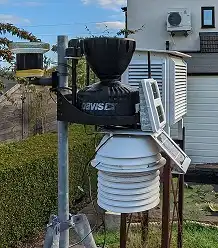 The first decision to make is to choose between a cabled version and a wireless version. The cabled version has several advantages in that it takes it's power via cables so less in the way of battery replacements to worry about. You don't have to worry about interference and you can place your station further away from your house. However the disadvantage is that you have to run the cables, cables can be damaged easily and once the site is chosen it's more difficult to move. Wireless however can easily placed but the location unless you use extenders has to be closer to the house. You have also have the issue of possible interference from other devices and also other Davis weather stations nearby. My recommendation though is to go with the wireless model.
The first decision to make is to choose between a cabled version and a wireless version. The cabled version has several advantages in that it takes it's power via cables so less in the way of battery replacements to worry about. You don't have to worry about interference and you can place your station further away from your house. However the disadvantage is that you have to run the cables, cables can be damaged easily and once the site is chosen it's more difficult to move. Wireless however can easily placed but the location unless you use extenders has to be closer to the house. You have also have the issue of possible interference from other devices and also other Davis weather stations nearby. My recommendation though is to go with the wireless model.
Once you decided between cabled or Wireless the next option is choose whether you want daytime fars, 24 fars or just the basic unit. The basic unit doesn't have any fans to push air over the sensors, the 24hr fars pushes air day and night over the sensors however the batteries do run down overnight in the winter months and finally the the daytime fars which pushes air over the sensors only during daylight. Too ensure good accuracy choose the 24hr fars which is the model I use. If you decide to go for none fan option the daytime temperatures will be too high especially in the summer.
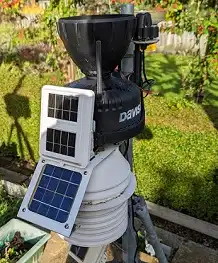 The basic Davis comes with rainfall, outside Humidity, outside temperature, Wind speed while the VP2 console adds Barometer, inside temperatures and humidity. The VP2 comes with the addition of UV, and solar radiation. The VP2 console comes as standard. You can also add sensors at a later date and even convert the none fars to a daytime fars unit when the funds come available. You will also need a tripod to mount the station. The image below left shows the 24hrs pro plus kit.
The basic Davis comes with rainfall, outside Humidity, outside temperature, Wind speed while the VP2 console adds Barometer, inside temperatures and humidity. The VP2 comes with the addition of UV, and solar radiation. The VP2 console comes as standard. You can also add sensors at a later date and even convert the none fars to a daytime fars unit when the funds come available. You will also need a tripod to mount the station. The image below left shows the 24hrs pro plus kit.
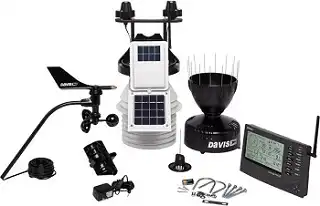 Once you've chosen the model version you want you then got to choose a site. Siting is actually easier with the Fars version as this can be placed in the sun ideally on grass as the fan will remove any heating of the housing by the sun. The none fars version I would place only in the shade if you place in the sun the readings will almost certainly be too high. To get an accurate wind speed the site will also need to be unsheltered however there's enough cable on the anemometer unit to locate it in better location. In my case a 25 foot pole.
Once you've chosen the model version you want you then got to choose a site. Siting is actually easier with the Fars version as this can be placed in the sun ideally on grass as the fan will remove any heating of the housing by the sun. The none fars version I would place only in the shade if you place in the sun the readings will almost certainly be too high. To get an accurate wind speed the site will also need to be unsheltered however there's enough cable on the anemometer unit to locate it in better location. In my case a 25 foot pole.
Setup and calibration of the Davis.
The model The weather station is fairly easy to setup although there are additional considerations in regards to the Barometer see this link for more details on how to do it.How to setup your Barometer Go through the setup as described in the manual and you should be up and running fairly quickly. In case you don't get any reception try another channel. There is also another a diagnostic test on the sensor suite too see if the unit as actually transmitting or not. After a few minutes you should see temperature and wind speed shown on the console. If you wish to calibrate the temperature you'll need to get readings from a local station ideally close by and at the same elevation. In my case since I had a Stevenson screen already at my house so adjusted the temperatures and humidity after allowing the unit to settle to the local environment. The calibration is done on the Vp2 console.
Day to day running of the Davis.
The station should run with nothing more than the seasonal maintenance although there are some issues which I'll discuss later. Temperatures and humidity are strong points of the Davis as is the wind speed. For the 24fars the difference tends to be 0.2CV either way. Over the year if you're comparing to Stephenson screen temperatures an unexplained larger difference may occur but this is rare. Rainfall you have to watch for debris getting caught in the collector so you need to keep that clear. The newer cones comes with a more secure filter which doesn't blow away. Even so the odd seed still gets blown in. The older tipping bucket design which features two buckets can be adjusted so you should be able to get it fairly close to the actual rainfall. However the tipping bucket buy it's nature does suffer accuracy problems especially during heavy rain. The newer design which features a single bucket cannot be adjusted and isn't accurate at all even with relative light rainfall so if you see an option to get the older dual bucket design get it. The Rain gauge can last years before the reed switch needs replacing which is a simple soldering job.
Common Issues with Davis VP2.
I'll deal with the simple issues first. You get a battery warning message on the console. Self explanatory you need to replace the batteries in the ISS. Once you replace the batteries the warning may stay a while before the super cap charges up. The super cap keeps the unit running when the sun goes down and when this discharges the battery takes over.
The rain doesn't register. The rain gauge is blocked and needs clearing.
The console keeps showing dashes. This is where communication is being lost if it only does once in a month then it's nothing much to worry about. If it does a lot it can either be interference or an issue with the battery or the super cap. The interference can be corrected by selecting another channel to broadcast on you'll have to run the setup again on the console once you changed the transmitter ID. You may have to change the channel more than once until you find one that is more stable.
You keep having to replace the batteries every week or so. This is the sign the super cap has blown. Contrary to what Davis say this is a design fault and affects the VP2 ISS console, leaf Wetness station and repeater stations. Davis said originally it was a faulty batch however the fault is still present years after then statement with people still reporting the issue.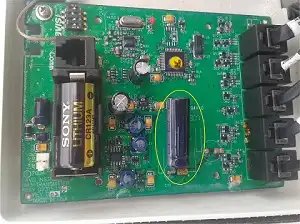 It may also effect the newer vantage vue stations although I haven't seen many comments about this. The image to the left shows a typical blown cap. The repair is simple and can be done in situ if one wishes to do so. The capacitors can be bought online so buy a few spares. This is mainly because the cap seems to be across a 3V line and is only rated at 2.7V hence the pop over time. Unfortunately you can't buy a higher rated voltage for this capacitor so after a few years it's likely to blow again. The wireless repeater uses different capacitors which can bought with a higher voltage rating and don't blow once you've replaced them. To make life simple I cut the blown capacitors legs cleaned them and then soldered the new one to the original legs. This means you can do an in situ replacement fairly quickly. This shouldn't happen of course and is the biggest markdown for the Davis System.
It may also effect the newer vantage vue stations although I haven't seen many comments about this. The image to the left shows a typical blown cap. The repair is simple and can be done in situ if one wishes to do so. The capacitors can be bought online so buy a few spares. This is mainly because the cap seems to be across a 3V line and is only rated at 2.7V hence the pop over time. Unfortunately you can't buy a higher rated voltage for this capacitor so after a few years it's likely to blow again. The wireless repeater uses different capacitors which can bought with a higher voltage rating and don't blow once you've replaced them. To make life simple I cut the blown capacitors legs cleaned them and then soldered the new one to the original legs. This means you can do an in situ replacement fairly quickly. This shouldn't happen of course and is the biggest markdown for the Davis System.
Recording data on a computer.
After a time you may wish to record the data onto your computer. For this you will need a data logger and software. You can buy a logger from Davis instruments which is a usb device. The device plugs into the back of vP2 console. Davis only provide the software Weatherlink once you signed up to weatherlink.com. The software is a free download and allows you display the weather data without the need for an internet connection. The Weatherlink software also allows you to create reports. This runs on a pc and osx. You can also view the data online at weatherlink.com and generate reports online. The usb option is expensive and in the past there has been connection issues relating to the quality of the cable connection. Other suggestions it was due to buggy software however I could replicate the fault simply by tapping on the connector after a few months. Davis also used to do an Ethernet connection but this has been discontinued but you may pick one up on ebay easily enough. Luckily they are cheaper options. The best of these are the wifi logger 2 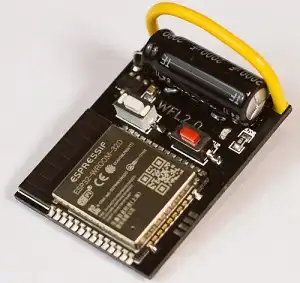 which also plugs into the back of the Davis VP2 console and then connects to home wifi. you can see what the logger looks like from the picture on the left. The logger can also upload to weatherlink.com and also several other websites including weather underground, Met office WOW and many others. It also allows you to connect to Weatherlink software on your pc and third party programs such as CumulusMX and weather display. If you prefer an Ethernet connection
which also plugs into the back of the Davis VP2 console and then connects to home wifi. you can see what the logger looks like from the picture on the left. The logger can also upload to weatherlink.com and also several other websites including weather underground, Met office WOW and many others. It also allows you to connect to Weatherlink software on your pc and third party programs such as CumulusMX and weather display. If you prefer an Ethernet connection 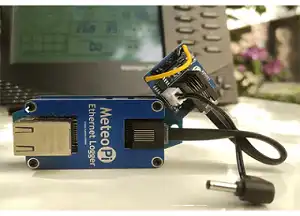 this also can bought from the same company. I haven't tried one so cannot comment on how well this works or not. There is also a version for the raspberry pi so basically all the options are covered.
this also can bought from the same company. I haven't tried one so cannot comment on how well this works or not. There is also a version for the raspberry pi so basically all the options are covered.
Apart from weatherlink there are several free programs you can buy for the pc. One is Cumulusmx which is a favourite of mine. This runs on Windows and Linux but not on OSX. The software basically runs a web server and is accessed via a web browser. You will also need a little knowledge of MySQL for the database but don't let that put you off as my knowledge of MySQL is very basic. PHP is also needed if you're going to display data and graphics on your website. To display live data from Cumulus on the web you need a front end like steel gauges which you'll see on my website. Support for CumulusMX is good. The other software I use is Weather Display. The configuration isn't as clean as it could be and there's some duplication however support is also good. My main reason why I use Weather Display is that it supports twitter which CumulusMX doesn't. You'll need another add on called croncloud to schedule the upload. To display data on your website you'll need freshwdl or steel Gauges. You don't need PHP or MySQL for Weather Display which is one advantage.
| Davis Weather Station Overall | |
|---|---|
| Pros | Cons |
| Temperature, Humidity, Barometer Accuracy one of the best | New Rainfall Unit inaccurate and doesn't have any adjustment |
| Easy to configure | Expensive |
| Indoor sensors | Design fault in regard to capacitors. So soldering skills needed |
| Good Mobile App | To unlock other services you have to pay |
| Desktop software now free from Weatherlink.com | Support is based in America so returning parts under warranty expensive due to shipping. |
| Some good third party weather applications available | |
| Davis support quick and responsive | |
Davis Web Site and Suppliers for Davis equipment
Full information and specifications can be found at Davies Website, https://www.davisinstruments.com/.org.uk , A good place to buy is the weathershop https://www.weathershop.co.uk/brands/davis-instruments , My favourite site https://www.weatherstations.co.uk , Spares can bought from https://weatherspares.co.uk/collections/davis-instruments, Wifi, Ethernet and Rasperberry PI Logger information can found at this site https://wifilogger.net CumulusmX support CumulusMx forums Weather Display Forums https://www.weather-watch.com/smf/